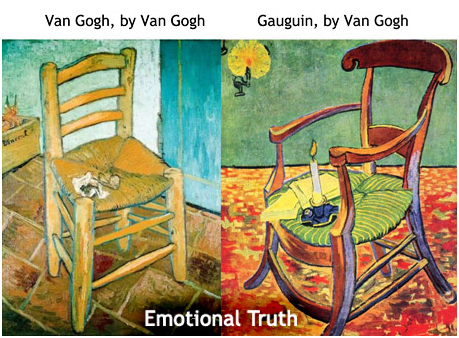Most entrepreneurs are a special kind of person, man or woman, they generally are remarkable in more than one way. spending time understanding some of the way in which YOU are manipulated every day to buy things you don't really need, with money you should spend on something else , has got to be of use. It might be fluffy but you fall for it every day! The best way to arm yourself is to see how brand, ad, and PR people think. It sounds so far out initially!
We talk of Emotional Intelligence, yet too often forget to consider what the target or object of (that human, not that automaton) our communications or actions senses and feels. We are mistaken if we think that decisions are completely logical and based on a utilitarian view of the world. Consider the following metaphor/example of how interest was roused, emotions stirred, understanding conveyed, and a desired outcome won.
Prompted by Theo, an art dealer and van Gogh’s younger brother, Vincent had decided that he wanted Paul Gauguin to join him in Arles and together begin a movement there that would galvanise the European art scene. How did he succeed in getting Gauguin to join him Gauguin, tempted, but undecided was older than van Gogh, worldlier, and better recognised in the circles van Gogh wished to move. He was studious and meticulous, carefully contemplating each brush-stroke. On the other hand the instinctive and impetuous van Gogh painted fast, fueled by emotion. They could learn much from each other – but how to give Gauguin that final push and get him to make the journey from Paris? Van Gogh wrote saying he had completed a self-portrait as well as one of Gauguin. Intrigued and flattered, the elder artist came to Arles. This is what awaited him and prompted him to stay:

Van Gogh’s chair was one he used daily – the natural light, the bare floor, the pipe, tobacco box of onions, as well as the colour palette, display his rustic self-view. Gauguin’s chair reveals a more sophisticated man, the candle light, the books wall to wall coloured carpet show his worldly embrace. They are not literal self-portraits – yet they convey a deeper truth, the Emotional Truth, context in a wider eco-system. Just as the picture your eyes reveals to you as you read these words is a true reflection of reality, stop and consider a moment, that as much as 60% of the image has been filled in by your brain. (The rods and cones, light and movement sensitive cells in your eye are not uniformly distributed, and are completely absent in that portion of your eye where the optic nerve connects your eye to your brain!! This is one of many autonomous processing functions our brains perform, and our actions and decisions are more often driven by these than many would care to acknowledge. )
To re-enforce the point above, how often have you as a parent complained "Don't use emotional blackmail on me!"
For brands that bear the organisation’s name – from Nando’s to Nike, from Sony to Saachi & Saachi – the emotional truth connects inner purpose with prospect. The Nike purpose is: “To bring inspiration & innovation to every athlete in the world”. Their emotional truth, best expressed in a TV commercial launched at the time of the London Olympics, showing hundreds of athletes of all ages all over the world, participating rather than winning, is ”Find Your Greatness.”
For multi-brand companies, the purpose should be constant for the organisation, while each brand finds its own emotional truth. Unilever has defined its corporate purpose as “adding vitality to life”. This is how its purpose cascades into attributes, rational benefits & emotional truth for Dove, one of the fastest growing brands in the Unilever stable.

The insight to feature women of different shapes & sizes in advertising come from research where female consumers complained of adland’s impossibly, perfect bodies. Using this emotional truth led to the highest viewed branded video on YouTube, with more than 50 million unique viewers.
When Dove decided to double its brand territory by bringing out a range for men, research again provided the direction.
"We hear from 73% of men that they're falsely or inaccurately depicted in advertising” Rob Candelino, Unilever VP-skin-care marketing.
There were three alienating stereotypes:
Dove wanted something to show real men in real life and what most men in Dove's target market segment say is "First and foremost, I'm a dad”
And that’s what Dove Men + Care showed, in print & TV. The “+ Care” part of the name encapsulates rational benefit & the emotional truth. As the brand cares for your skin, you show your care as a dad.
For that younger guy, Unilever has Axe, adding vitality to life in a way that would be a stereotype, but for the humor.
For their leading washing powder, Unilever captured another emotional truth.

Attributes only convince & excite those who develop them. We give rational benefits half an ear, as they do not fully answer the million dollar question.......
Why should I choose you?
The answer to this question can sometimes be because you are the cheapest, or most accessible, or newest. More often though and best for growth is the answer:- Because you really understand me – you get me.”
An emotional truth, whether by Van Gogh, Unilever or Nike contains deep insight on which you can build your enterprise and brand communications.
Ivan@Spark - Please note a lot of this work is that of someone else, whose details I cannot find buried in my archives!